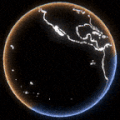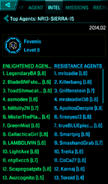The metrics of Ingress are as follows:

General
Meters: distances are checked in the metric unit of meters
Speed Limit:
- The Trekker badge checks that an agent is going less than 8 km/h.
- The Speed Lock checks that an agent is going slower than 60 km/h.
Checkpoints
Checkpoints are 5 hour MU progress checks for both the global and the Cell level. At every Checkpoint, the fields are assessed for their MU value and added together. They are not added to previous check points. The Checkpoints can be seen in the Intel Tab of the OPS menu. There are 35 Checkpoints for every Cycle where the average MU is taken for the final score.
Cycles

Cycles, also known as septi-cycles[1], are 175 hour "finish lines" that average the MU from 35 Checkpoints. The score is counted at the Global and Cell level.[2]
The ongoing tally can be seen under the "Intel" tab of the OPS menu. Previous cycle scores can be viewed by tapping "History" at the bottom left corner. In addition, the top 50 Agents from each faction are ranked by their MU control throughout the cycle, which can be seen by tapping "See other agents" under the cell map.
Cycles have no real effect on gameplay, other than acting as a scoreboard.[3] However, in rare cases cell scores at the end of a cycle have been used to determine the outcome of an anomaly, such as during Helios.[1]
Gallery
Exotic Matter
Exotic Matter or XM is a transdimensional energy discovered by researchers at CERN (Switzerland) who were searching for a so called "God particle". It is a resource collected by the Scanner and drained with most actions made with the Scanner. XM is represented as glowing bluish-white dots throughout the world. XM tends to appear more around areas of high Scanner usage, such as public transport stops and city centers. XM also appears clustered around a Portal. The Scanner stores XM and uses it to perform most actions other than collecting more XM and restoring XM via a Power Cube ![]() . If the XM stored reaches critical levels (below 1%) the Scanner will become disabled until sufficient XM has been restored. In addition to being unable to perform any actions that require XM, a disabled Scanner may not be able to perform other actions such as viewing Resonators
. If the XM stored reaches critical levels (below 1%) the Scanner will become disabled until sufficient XM has been restored. In addition to being unable to perform any actions that require XM, a disabled Scanner may not be able to perform other actions such as viewing Resonators ![]() or Mods. A disabled Scanner can still activate a Power Cube
or Mods. A disabled Scanner can still activate a Power Cube ![]() and recycle items.
and recycle items.
To acquire XM from the ground, the Scanner needs to be brought within the action range (40 meters, shown by the orange ring); the XM will be drawn to the Scanner and added to the total carried. XM can be collected about every 3 seconds.[Outdated] XM can also be obtained by using Passcodes, Power Cube ![]() and recycling items. The collected XM disappears until it naturally regenerates after about 25 minutes.
and recycling items. The collected XM disappears until it naturally regenerates after about 25 minutes.
The bar next to the Agent's level shows how much XM you have relative to your total capacity. Capacity increases along with the Agent's level. Once the Scanner has reached 100%, it cannot collect any additional XM.
Mind Units

Mind Units (MUs) are the primary scoring metric of Ingress. Mind Units (MUs) represent the population within a Control Field Δ. Mind Units (MUs) are calculated once at each Checkpoint for Cell scores every five hours and combined into the Global score. However, only Cycle ○ scores (35 checkpoints; 175 hours) will be recorded into global history. If a Control Field Δ covers multiple Cells at a scoring Checkpoint, the Mind Units (MUs) are divided proportionally between the regional Cells that the Control Field Δ covers based on the fraction of the area of the Control Field Δ that is in each Cell.
Access
From the Scanner, touch OPS > Scores to access the Global MU view.
Regional Mind Unit scoring
This competition hinges on maintaining control of those Mind Unit (MU) Control Field Δ through key scoring Checkpoints that happen every five hours. Each competition period has a 175 hour duration. If a Control Field Δ is maintained through the Checkpoint time, then those Mind Units (MUs) are added to that Faction's running score in that Cell. The Faction with the highest average Mind Unit (MU) score at 175 hour Cycle end, wins that Cycle.
The ENL and RES bar charts show the average Mind Units (MUs) scored during the current 175 hour competition Cycle. This score is not the same as the global Mind Unit count shown on the Intel Map, which reflects total Mind Units (MUs) held at that point in time.
Regional Cell View
Each geographic Cell has a unique codename. For example, the Cell in the image above is identified as AM01-CHARLIE-02. Cell codenames currently cannot be nicknamed by Agents.
The ENL and RES bar charts show the the average Mind Units (MUs) scored during the current 175 hour competition Cycle. This score is an average of the Mind Units (MUs) that are maintained by each Faction through the scoring Checkpoints that occur every five hours.
Touching History will show the historical results of Cycles for that particular Cell.
Top Agents
Touch SEE OTHER AGENTS from the regional Cell view to display the Top 50 Agents per Faction for the current Cycle and Cell.
The Top Agents are ranked by Mind Units (MUs) captured during the current Cycle. Only the Agent who creates the third Link and completes a Control Field Δ will receive Mind Units (MUs) credit toward the Top Agents list. If you created a Control Field Δ that was destroyed before a Checkpoint measurement, the Mind Units (MUs) would count toward your Top Agents ranking but not towards the total regional Cell score.
View Other Cells
Touch CELL ACTIVITY to view a list of neighboring Cells that surround the regional Cell in which you are currently located. You can view Cell Activity for nearby Cells, but we do not currently offer an option to search for or view specific Cells.
Planning
Niantic does not officially produce a tool to calculate the MUs in an area in advance. However, Agents can use other sources of population density to estimate the MUs in an area.
The number of MUs is not directly the actual population of an area. As a quick approximation, the MUs number is closest to two thirds of the population count.
The "population count", in turn, is not calculated directly by summing together the population densities. Agents have noticed that sometimes a Control Field Δ that extends into a less populated area actually has fewer MUs than a smaller Field Δ that is fully enclosed by the bigger Field Δ and does not extend into a less populated area. One hypothesis is that the calculation runs by:[4][5]
- The Scanner divides the Control Field Δ into S2 Cells down to a size-level, determined such that there are not too many Cells in the Field Δ.
- For the Cells that are fully covered, their entire population is counted. For the Cells that are partially covered, the population count is multiplied by percent coverage. All the pops are added together for a pop count estimate.
- The MU count is the pop count multiplied by two thirds.
However, as there is no population density data available in the form of S2 Cells, data miners can only propose hypotheses for how MU calculations work, but never directly produce a perfect calculator that reproduces game behaviour.
For a rough guess of how many MUs a Control Field Δ will net, just go back to the "first-order estimate" above. There are plenty of websites that tell you how many people live in a polygon area. Multiply that by two-thirds, and that is your guesstimate.
- ↑ 1.0 1.1 Stuart Davis's answer to "What is an Ingress global cycle? What happens when a cycle ends?" — Quora
- ↑ "Regional Scoring - This Changes Everything" — DeCode Ingress
- ↑ "So, what happens at the end of cycles?" — r/Ingress (reddit.com)
- ↑ How are the MU numbers calculated? on Reddit
- ↑ how is MU calculate? and is Ingress using up-to-date data? on Ingress Forum (Wayback Machine). See, in particular, the Google Docs link posted by TheRedSeven.


